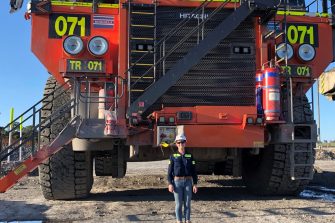The quest for the Holy Grail of clean energy
Through the creation of new and improved radiation-tolerant materials, the pathway to clean and plentiful energy is right at our doorstep.

Share this story
While the process of fusion energy has been known for many years, the development of materials necessary to turn fusion into a commercially feasible option have presented a number of challenges. In researching the degradation mechanisms of materials used in energy applications however, Prof. Patrick Burr and his team are creating new materials designed to withstand the extreme conditions of fusion reactors. Through this work, they’re paving the way for an abundant source of cost-effective and clean energy that will turn viable fusion energy into an everyday reality.
Left: A/Prof Edward Obbard. Middle: A/Prof Patrick Burr. Right: Dr. Conor Galvin
From advanced aerospace to conventional nuclear power and beyond, the industries and communities set to benefit from fusion energy are vast. “Fusion is the holy grail of clean energy,” says Prof Burr. “Just 1kg of fusion fuel provides the same amount of energy as 100,000 tonnes of coal.” Fusion, which is the opposite reaction of nuclear fission (which powers conventional nuclear power plants) – provides a range of future-use opportunities. These have been difficult to bring to life however as fusion has always been a challenge to sustain. “It’s always been a bit out of reach because we haven’t developed the materials that can withstand the extreme environment of high temperatures and radiation of fusion for long enough,” he adds.
Conventional materials have allowed us to show that fusion energy is possible, but these tests only lasted a few milliseconds to mere seconds at most. Current materials can’t endure the extreme environment needed to create fusion energy, a hundred million degrees and lots of high-energy radiation, for very long. “To make this technology a commercial reality, we need materials that can last years before they need to be replaced,” Prof. Burr explains. “If we know the mechanism by which a material degrades, however, then we can create materials that are more resistant to that process, and they are also more sustainable because they last longer.”
In better harnessing fusion energy, Prof. Burr believes the potential for fusion is limitless. “We only need tiny amounts of fusion to produce a lot of energy, and that opens us up to all sorts of ideas including using the heat for processing to make steel and aluminium, as well as considering other ideas such as space propulsion.”
Advanced shielding materials
As part of Professor Burr’s ongoing research, his team are collaborating with start-up organisation, Tokamak Energy – a world-leader in the race for commercial fusion energy. One of these projects involves the development of new shielding materials that tolerate the radiation damage caused by high-energy neutrons and gamma rays. These advanced metal ceramic composites not only absorb doses of high-level radiation without degrading but also withstand extremely high and low temperatures.
The goal of this work is to develop an understanding of the radiation damage in these advanced shielding materials when exposed to fusion radiation, and the effect this may have on the properties of the material. “If our predications are sound, and we can make a small shield that’s more effective and efficient in producing more energy, this means we’re one step closer to commercialisation,” he says. This would create a number of opportunities for use both on the ground and within the field of space exploration.
“Satellites get battered by radiation, so what if we could make better shields for space – or even for medicine? Could it make life better for patients, nurses and doctors? The possibilities are endless.”
- Professor Burr
A tokamak is a doughnut-shaped machine that uses very powerful magnets to confine plasma in a vacuum where it is heated to such high temperatures that nuclei can fuse together and release energy. Image: Getty Images
UNSW student, Harvey Ling's virtual rendition of what the UNSW Tokomak device (currently under development) might look like (to scale).
In exploring and developing materials for extreme environments, Prof. Burr and his team are pushing the boundaries of what these materials can do while also using these discoveries across a range of applications such as space, medicine, solar power and the hydrogen economy. “It will completely change the way we do energy as well as impact a number of other areas in nuclear medicine, space propulsion and as a source of high temperature heat for industrial uses like clean hydrogen and green steel… I can even imagine it one day being used in every household, a bit like we use microwaves today.” Importantly, Prof. Burr believes the future of fusion energy and the impact it will have is closer than we think.
”Fusion is going to happen in my lifetime, I’m sure of it. It’s these new and improved materials that are the key enablers for commercial, clean and abundant fusion energy.”
- Professor Burr
Share this story
Read more
Get in touch and see what’s possible.
Ask how we can help your business, industry or market through collaboration.



